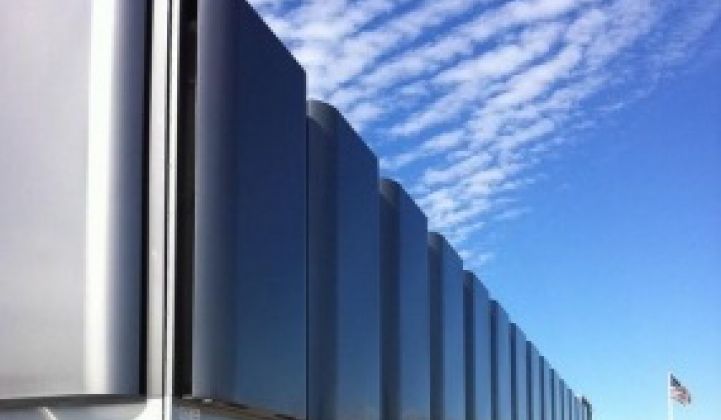News on Bloom Energy continues to roll in.
Last week we reported on the $130 million round of funding for Bloom, the decade-old fuel cell firm that has drawn down more than $1.1 billion in venture capital funding. (Also see last month's detailed update on the fuel cell industry.) A panel at a recent SVLG Summit had Xilinx's Matt Jorgensen presenting on his company's positive experience with a 1-megawatt Bloom Box installation. We'll get you more details on that case study shortly.
But today's report concerns a proposed 400-kilowatt Bloom Energy fuel cell facility at Santa Clara California's Valley's Transportation Authority (VTA), the Guadalupe Fuel Cell site.
The project was to receive $750,000 in federal funds in addition to the usual SGIP and other subsidies toward the approximately $5.8 million price tag. As Silicon Beat reported in 2012, the bidding process for that $750,000 U.S. Department of Transportation grant was less than transparent and the project was sent back to be re-bid despite the efforts of Democratic House members Zoe Lofgren (D-San Jose), Anna G. Eshoo (D-Palo Alto) and Mike Honda (D-Campbell).
Using the numbers supplied, that works out to more than $10,000 per kilowatt, which sounds about right for a Bloom Box, although a bit high for a competitive power source.
The initial proposed financial structure involved a 20-year power purchase agreement (PPA) with third party AEDG, which claims "a 30-megawatt fuel cell development pipeline spanning commercial, not-for-profit and public sector entities in the United States," according to the firm's website.
But in a memorandum dated March 29, the VTA noted that the proposed "financial structure was not achievable due to insufficient financial return for the third-party capital investor." That would be AEDG, which has not returned our calls as of press time. AEDG backed out, leaving VTA with the option of selling bonds to finance the project or buying the project outright.
Instead, VTA General Manager Michael T. Burns suggested that the Authority adopt a wait-and-see stance as the technology improves. And as of April 4, the staff has recommended that "the VTA not proceed with Bloom Energy on the proposed facility for cost and risk expenses."
Bloom builds fuel cells of the solid-oxide variety with natural gas as the fuel. There is no heat resource in the Bloom Box as in other CHP fuel cells. The 200-kilowatt units are intended for commercial and industrial applications, and in 2012 the firm shipped scores of megawatts to an all-star list of customers, including Adobe, FedEx, Staples, eBay, Google, Coca-Cola, and Wal-Mart.
Fuel cells can be distributed and do have less emissions. Natural gas is currently cheap. But for fuel cells dependent on the natural gas grid, there's the downside of volatile prices and the sometimes less-than-green processes used to extract natural gas.
Fuel cells have benefited from state and federal subsidies, or in the case of Bloom, Delaware ratepayer bill subsidies.
The long-term reliability of the fuel cell stack remains a risk, and some have doubted Bloom's green claims and employment practices.
An excerpt from the VTA memorandum is below. The full document is here.


Thanks to Lindsay Leveen for spotting the VTA document.



